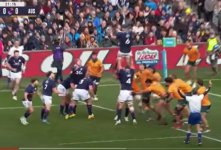I am not reluctant, I just thought it was obvious from my previous emails. He is legal because he is in a position to receive the ball. Whether he did or not is irrelevant, as were his intentions.
.
well for me
d.
Leave the lineout so as to be in a position to receive the ball, provided they remain within 10 metres of the mark of touch and they keep moving until the lineout is over.
'so as to be' means 'in order to be' or 'with the intention of being' in a position to catch.
I don't think it gives the throwing team a licence to drop out of the lineout and stand 2m back.
What does anyone else think ?
in the case of scotland #7 he clearly wasn't legal as he didn't keep moving.
[LAWS]d.
Leave the lineout so as to be in a position to receive the ball, provided they remain within 10 metres of the mark of touch and they
keep moving until the lineout is over.[/LAWS]
which is all part of the same thing : he dodn't leave the lineout as 'peeler' to receive the ball, he left the line out to position himself behind the planned receiver of the ball, and to get momentum as he joined the maul




